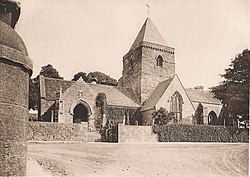Whitekirk: Difference between revisions
Created page with "{{Infobox town |name=Whitekirk |county=East Lothian |picture=Whitekirk.jpg |picture caption='The White Kirk' 1893 |os grid ref=NT610791 |latitude=56.0257 |longitude=-2.6486 |p..." |
mNo edit summary |
||
| Line 14: | Line 14: | ||
|constituency=East Lothian | |constituency=East Lothian | ||
}} | }} | ||
'''Whitekirk''' is a small village in [[East Lothian]]. It is close to the coastal village of [[Tyninghame]], with which it shares a parish ( | '''Whitekirk''' is a small village in [[East Lothian]]. It is close to the coastal village of [[Tyninghame]], with which it shares a parish ([[Whitekirk and Tyninghame]]). | ||
Whitekirk is four miles from [[North Berwick]], eight miles from [[Dunbar]] and 25 miles east of [[Edinburgh]], which latter city employs many of the commuters who live in Whitekirk. | Whitekirk is four miles from [[North Berwick]], eight miles from [[Dunbar]] and 25 miles east of [[Edinburgh]], which latter city employs many of the commuters who live in Whitekirk. | ||
Latest revision as of 18:06, 14 May 2022
| Whitekirk | |
| East Lothian | |
|---|---|
 'The White Kirk' 1893 | |
| Location | |
| Grid reference: | NT610791 |
| Location: | 56°1’33"N, 2°38’55"W |
| Data | |
| Post town: | Dunbar |
| Postcode: | EH42 |
| Dialling code: | 01620 870xxx |
| Local Government | |
| Council: | East Lothian |
| Parliamentary constituency: |
East Lothian |
Whitekirk is a small village in East Lothian. It is close to the coastal village of Tyninghame, with which it shares a parish (Whitekirk and Tyninghame).
Whitekirk is four miles from North Berwick, eight miles from Dunbar and 25 miles east of Edinburgh, which latter city employs many of the commuters who live in Whitekirk.
A place of Christian worship from the earliest times, its name is the same as the many places across the land named Whitchurch; it is from the Old English Hwit Cirice, meaning "White Church". The village had a 'holy well', now lost, dedicated to St Mary the Virgin, and before the Reformation it had a famous statue, likewise dedicated and known as Our Lady of Haddington. It was on the pilgrim's route from St Andrews to Santiago de Compostela and described as a stopping point in the Iter pro peregrinis ad Compostellam., Book V of the Codex Calixtinus.
Shrine and pilgrimages
The shrine of Our Lady at Whitekirk was desecrated by the armies of Edward III of England in 1356, a period that would become known as the Burnt Candlemas. Later in the 14th century, the shrine was reconsecrated at the newly built Church of St Mary the Virgin in Haddington. Whitekirk continued to be a place of pilgrimage, however, receiving visits from the future Pope Pius II and Kings James IV and James V.
In early 1435, Aeneas Piccolomini (later Pope Pius II) was travelling to Scotland on a diplomatic mission as Papal legate, when his ship was beset by storms. After giving prayers to Our Lady (Mary), the ship and its crew made port safely at Dunbar, and having promised to walk barefoot to the nearest shrine to the virgin, Piccolomini set out for Whitekirk. The eight miles through the frozen countryside left him with rheumatism that he would complain about for the rest of his life.
The pilgrimages were stopped at the Reformation.
The Covenanting preacher John Blackadder gave his last conventicle on the hill behind the Church in 1678.
The Holy Well dried up in the 19th century following agricultural drainage, but is thought to be located not far from the church building.
The current Church was last restored in 2005-6. Dramatic events in 1914 saw the Church set on fire, allegedly by Suffragette campaigners, although this has not been proven. The Kirk was restored by the office of Sir Robert Lorimer.
Whitekirk derives its name from the original colour of the Kirk: White, and was once known as 'Hamer' or the greater Ham. The Church is now the red of its underlying sandstone.
Whitekirk Pilgrimage
On the 2nd Saturday of May, every year since 1971, there is an ecumenical pilgrimage that starts at Whitekirk and finishes in Haddington. Originally started by the Patrick Maitland the 17th Earl of Lauderdale, the numbers attending rose from 30 people in the early seventies to over 2000; however, in 2008 the pilgrimage was cancelled due to lack of numbers.
Outside links
- [1] Details of Our Lady's Well, Whitekirk-now lost
- [2] Whitekirk Pilgrimage
- SCRAN Whitekirk to Haddington pilgrimage, 1988